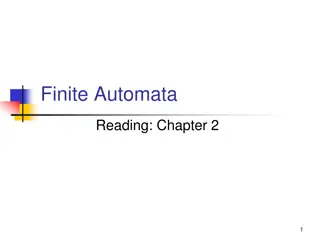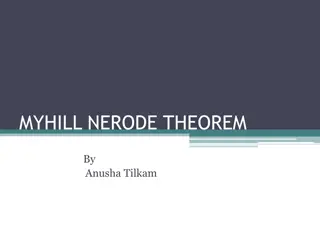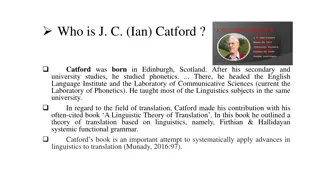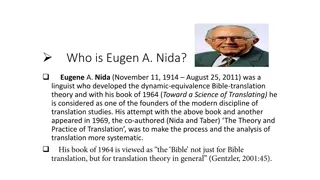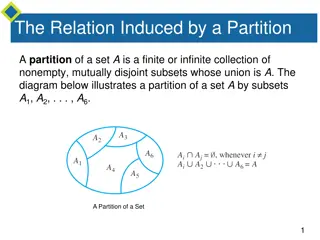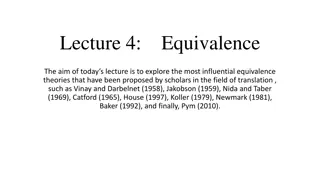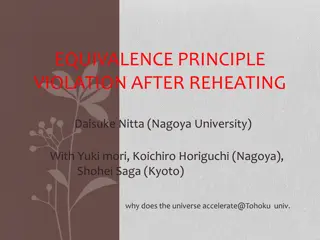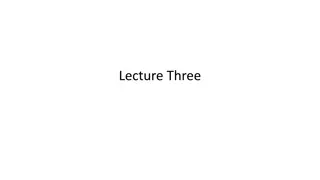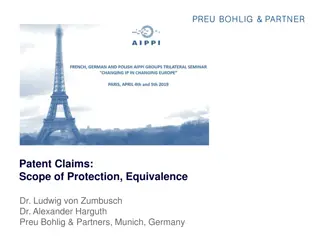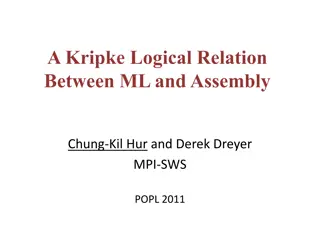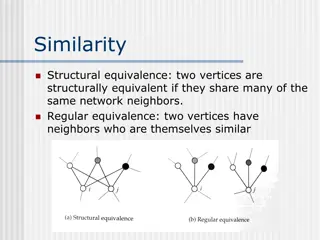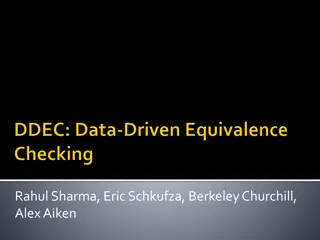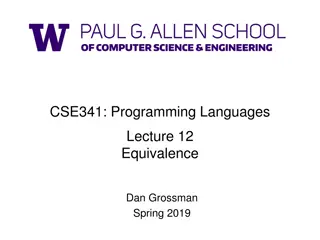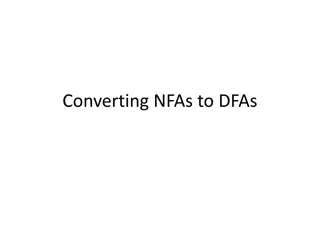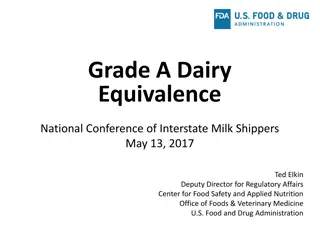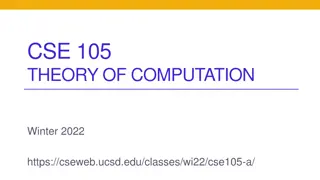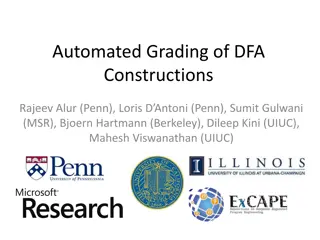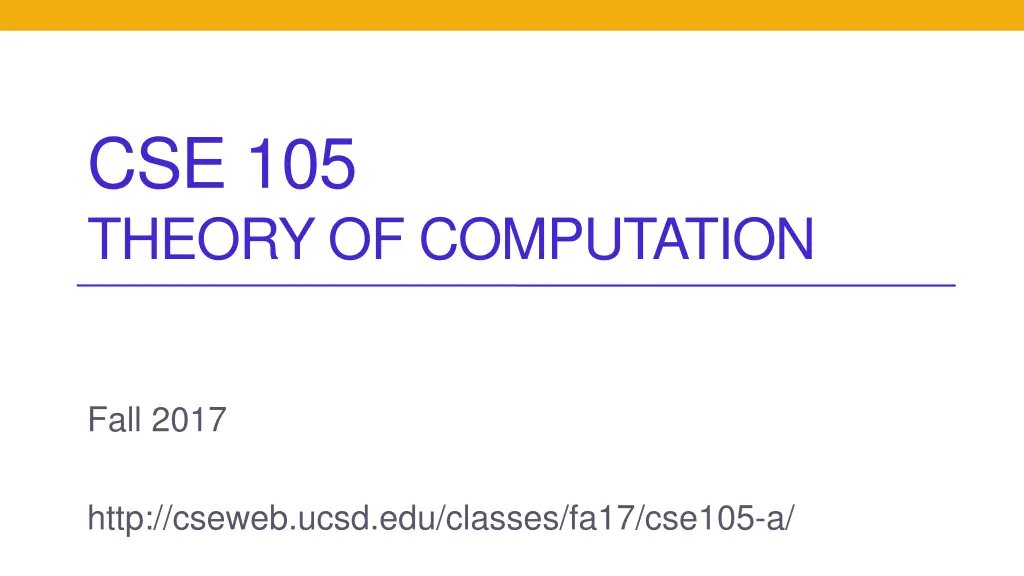
Theory of Computation: NFA, DFA, Regular Expressions, Automata
Explore the concepts of Nondeterministic Finite Automata (NFA), Deterministic Finite Automata (DFA), regular expressions, and automata in the Theory of Computation course. Learn about converting NFAs to DFAs, designing regular expressions, acceptance in an NFA, simulating NFAs with DFAs, and more.
Download Presentation

Please find below an Image/Link to download the presentation.
The content on the website is provided AS IS for your information and personal use only. It may not be sold, licensed, or shared on other websites without obtaining consent from the author. If you encounter any issues during the download, it is possible that the publisher has removed the file from their server.
You are allowed to download the files provided on this website for personal or commercial use, subject to the condition that they are used lawfully. All files are the property of their respective owners.
The content on the website is provided AS IS for your information and personal use only. It may not be sold, licensed, or shared on other websites without obtaining consent from the author.
E N D
Presentation Transcript
CSE 105 THEORY OF COMPUTATION Fall 2017 http://cseweb.ucsd.edu/classes/fa17/cse105-a/
Today's learning goals Sipser Ch 1.2, 1.3 Design NFA recognizing a given language Convert an NFA (with or without spontaneous moves) to a DFA recognizing the same language Decide whether or not a string is described by a given regular expression Design a regular expression to describe a given language Convert between regular expressions and automata
Nondeterministic finite automata "Guess" some stage of input at which switch modes Input M2 M1 "Guess" one of finite list of criteria to meet Accept if either (or both) accepts M1 Input M2
Simulating NFA with DFA Not quite a closure proof, but Proof: Given name variables for sets, machines assumed to exist. WTS state goal and outline plan. Construction using objects previously defined + new tools working towards goal. Give formal definition and explain. Correctness prove that construction works. Conclusion recap what you've proved.
Simulating NFA with DFA For any language recognized by an NFA, there is a DFA that recognizes this language. Proof: Given A, a language recognized by N = (Q, , ,q0,F) a NFA WTS there is some DFA M with L(M) = A Construction Correctness Conclusion
From NFA to DFA Which of the following strings is accepted by this NFA? A. The empty string B. 01 C. 111 D. 0 E. More than one of the above.
Subset construction Given A, a language recognized by N = (Q, , ,q0,F) a NFA WTS there is some DFA M with L(M) = A ConstructionDefine M = (Q', , ',q0', F') with Q' = the power set of Q = { X | X is a subset of Q } q0' = { states N can be in before first input symbol read } F' = { } ' ( ) =
From NFA to DFA Which states can this NFA be in before first input symbol is read? A. q0 B. any state C. q0, q1 D. q0, q4 E. q0, q1, q4
Subset construction Given A, a language recognized by N = (Q, , ,q0,F) a NFA WTS there is some DFA M with L(M) = A ConstructionDefine M = (Q', , ',q0', F') with Q' = the power set of Q = { X | X is a subset of Q } q0' = { q0 } U ((q0, )) F' = { } ' ( ) =
Subset construction Given A, a language recognized by N = (Q, , ,q0,F) a NFA WTS there is some DFA M with L(M) = A ConstructionDefine M = (Q', , ',q0', F') with Q' = the power set of Q = { X | X is a subset of Q } q0' = { q0 } U ((q0, )) F' = { guarantee at least one computation is successful } ' ( ) =
From NFA to DFA What does it mean for a set of states X to guarantee at least one computation is successful? A. X is a subset of F B. X = F C. X F is nonempty D. X is an element of F E. None of the above. U
Subset construction Given A, a language recognized by N = (Q, , ,q0,F) a NFA WTS there is some DFA M with L(M) = A ConstructionDefine M = (Q', , ',q0', F') with Q' = the power set of Q = { X | X is a subset of Q } q0' = { q0 } U ((q0, )) F' = { X | X is a subset of Q and X F is nonempty } ' ( (X, x) ) = { } U
Subset construction Given A, a language recognized by N = (Q, , ,q0,F) a NFA WTS there is some DFA M with L(M) = A ConstructionDefine M = (Q', , ',q0', F') with Q' = the power set of Q = { X | X is a subset of Q } q0' = { q0 } U ((q0, )) F' = { X | X is a subset of Q and X F is nonempty } ' ( (X, x) ) = { q in Q | q is in (r,x) for some r in X or accessible via spontaneous moves} U Types?
Recap Regular sets of strings i.e., those that aren't too complicated are those that are the language of some DFA, or equivalently, the language of some NFA. If a set of strings can be expressed as the result of complement, union, intersection, concatenation, Kleene star of regular languages, then it itself is regular.
Regular expressions Can all regular languages be expressed as those that are built up from very simple languages using the regular operations?
Inductive application of closure R is a regular expressionover if Sipser 1.52 p. 64 Watch out for overloaded symbols! is shorthand for (0 U 1) if = {0,1}, Parentheses may be omitted, R+ means RR*, Rk means R concatenated with itself k times
Syntax Languages The language described by a regular expression, L(R): L ( (0 U 1)U1 ) = { } L ( ) = { } L ( ) = { }
L(R) Which of the following strings is not in the language described by ( ( (00)*(11) ) U 01 )* A. 00 B. 01 C. 1101 D. E. I don't know
L(R) Let L be the language over {a,b} described by the regular expression ((a U ) b*)* Which of the following is not true about L? A. Some strings in L have equal numbers of a's and b's B. L contains the string aaaaaa C. a's never follow b's in any string in L D. L can also be represented by the regular expression (ab*)* E. More than one of the above.
Regular expressions in practice Compilers: first phase of compiling transforms Strings to Tokens keywords, operators, identifiers, literals One regular expression for each token type Other software tools: grep, Perl, Python, Java, Ruby,
"Regular = regular" Sipser Theorem 1.54 p. 66 Theorem: A language is regular if and only if some regular expression describes it. Lemma 1.55: If a language is described by a regular expression, then it is regular. Lemma 1.60: If a language is regular, then it is described by some regular expression

